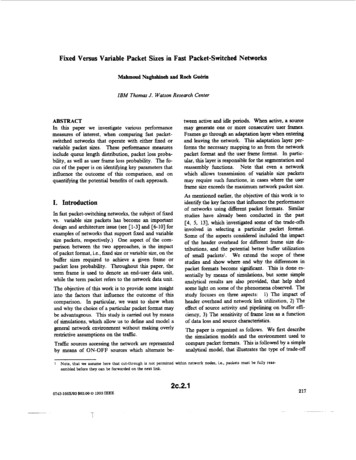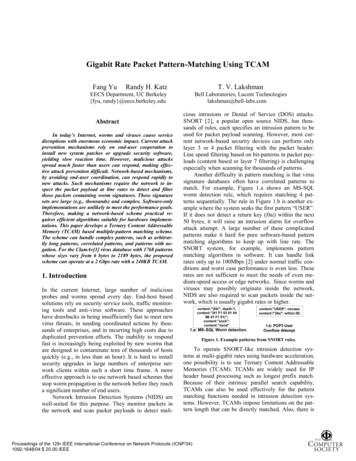
Transcription
Gigabit Rate Packet Pattern-Matching Using TCAMFang YuRandy H. KatzT. V. LakshmanEECS Department, UC Berkeley{fyu, randy}@eecs.berkeley.eduAbstractIn today’s Internet, worms and viruses cause servicedisruptions with enormous economic impact. Current attackprevention mechanisms rely on end-user cooperation toinstall new system patches or upgrade security software,yielding slow reaction time. However, malicious attacksspread much faster than users can respond, making effective attack prevention difficult. Network-based mechanisms,by avoiding end-user coordination, can respond rapidly tonew attacks. Such mechanisms require the network to inspect the packet payload at line rates to detect and filterthose packets containing worm signatures. These signaturesets are large (e.g., thousands) and complex. Software-onlyimplementations are unlikely to meet the performance goals.Therefore, making a network-based scheme practical requires efficient algorithms suitable for hardware implementations. This paper develops a Ternary Content AddressableMemory (TCAM) based multiple-pattern matching scheme.The scheme can handle complex patterns, such as arbitrarily long patterns, correlated patterns, and patterns with negation. For the ClamAv[1] virus database with 1768 patternswhose sizes vary from 6 bytes to 2189 bytes, the proposedscheme can operate at a 2 Gbps rate with a 240KB TCAM.1. IntroductionIn the current Internet, large number of maliciousprobes and worms spread every day. End-host basedsolutions rely on security service tools, traffic monitoring tools and anti-virus software. These approacheshave drawbacks in being insufficiently fast to meet newvirus threats, in needing coordinated actions by thousands of enterprises, and in incurring high costs due toduplicated prevention efforts. The inability to respondfast is increasingly being exploited by new worms thatare designed to contaminate tens of thousands of hostsquickly (e.g., in less than an hour). It is hard to installsecurity upgrades in large numbers of enterprise network clients within such a short time frame. A moreeffective approach is to use network based schemes thatstop worm propagation in the network before they reacha significant number of end users.Network Intrusion Detection Systems (NIDS) arewell-suited for this purpose. They monitor packets inthe network and scan packet payloads to detect mali-Bell Laboratories, Lucent Technologieslakshman@bell-labs.comcious intrusions or Denial of Service (DOS) attacks.SNORT [2], a popular open source NIDS, has thousands of rules, each specifies an intrusion pattern to beused for packet payload scanning. However, most current network-based security devices can perform onlylayer 3 or 4 packet filtering with the packet header.Line speed filtering based on bit-patterns in packet payloads (content based or layer 7 filtering) is challengingespecially when scanning for thousands of patterns.Another difficulty in pattern matching is that virussignature databases often have correlated patterns tomatch. For example, Figure 1.a shows an MS-SQLworm detection rule, which requires matching 4 patterns sequentially. The rule in Figure 1.b is another example where the system seeks the first pattern “USER”.If it does not detect a return key ( 0a ) within the next50 bytes, it will raise an intrusion alarm for overflowattack attempt. A large number of these complicatedpatterns make it hard for pure software-based patternmatching algorithms to keep up with line rate. TheSNORT system, for example, implements patternmatching algorithms in software. It can handle linkrates only up to 100Mbps [2] under normal traffic conditions and worst case performance is even less. Theserates are not sufficient to meet the needs of even medium-speed access or edge networks. Since worms andviruses may possibly originate inside the network,NIDS are also required to scan packets inside the network, which is usually gigabit rates or higher.content:" 04 "; depth:1;content:" 81 F1 03 01 049B 81 F1 01 ";content:"sock";content:"send"1.a: MS- SQL Worm detection.content:"USER"; nocase;content:!" 0a "; within:50;1.b: POP3 UserOverflow AttemptFigure 1. Example patterns from SNORT rules.To operate SNORT-like intrusion detection systems at multi-gigabit rates using hardware acceleration,one possibility is to use Ternary Content AddressableMemories (TCAM). TCAMs are widely used for IPheader based processing such as longest prefix match.Because of their intrinsic parallel search capability,TCAMs can also be used effectively for the patternmatching functions needed in intrusion detection systems. However, TCAMs impose limitations on the pattern length that can be directly matched. Also, there isProceedings of the 12th IEEE International Conference on Network Protocols (ICNP’04)1092-1648/04 20.00 IEEE1
no direct method to handle correlated patterns such asthe example patterns shown in Figure 1. In this paper,we develop algorithms that use TCAMs to achieve highspeeds while not being restricted to these limitations.Our work is applicable to other layer 7 patternmatching problems. For example, applications likeHTTP load balancing, email SPAM filtering, etc., require packet payload scanning. In this paper, we develop and test algorithms for intrusion detection andanti-virus signature sets because they are more complexthan the signatures of the applications listed above.The remainder of this paper is organized as follows: we review related work and summarize the relevant TCAM background in Section 2. We define a generalized pattern format based on the analysis of different signature sets in Section 3. Section 4 presents ourscheme to map the multiple patterns into TCAM andefficiently scan packets at high speeds. Section 5 analyzes our scheme and discusses strategies against malicious attacks. We present simulation studies on both thereal world traces and synthesized worst case traffic inSection 6 and finally conclude the paper in Section 7.Recently, new pattern matching algorithms specifically for content-based packet handling have been proposed. The Aho-Corasick-Boyer-Moore (AC BM) algorithm proposed by Silicon Defense [5] combines theBoyer-Moore and Aho-Corasick algorithms. Anothernew algorithm is the Setwise Boyer-Moore-Horspoolalgorithm by Fish et al. [6], whose average case performance is better than Aho-Corasick and BoyerMoore. These algorithms greatly improve SNORT’spattern matching speed. However, it is still below theline rate needed for network deployment.FPGA solutionsPattern matching problems have been extensively studied. In this section, we only discuss approaches that arerelevant to the intrusion detection problem. We firstreview representative software-based schemes and thendiscuss FPGA and Bloom Filter based schemes that areamenable to hardware implementation. Finally we introduce TCAMs and related work that uses TCAMs.FPGAs can be programmed for fast pattern matchingdue to their exploitation of reconfigurable hardwarecapability and their ability for parallelism. To search fora regular expression of length n on an FPGA, one solution is to build a serial machine that requires O(2n)memory and takes O(1) time per text character. Sidhu etal. proposed a Nondeterministic Finite Automaton(NFA) approach using FPGAs [7]. Their approach requires only O(n2) space and is still able to process eachtext character in O(1) time.The above two approaches are optimized for singlekeyword searching and do not scale well for multiplepatterns. The recent work by Sidhu et al. uses a modified KMP algorithm [8]. Each pattern is still treatedindependently; however, multiple (100 reported in thepaper) patterns can be pipelined at gigabit rates. Themain concern is that patterns are searched sequentially,so the overall latency increases proportionally with thenumber of patterns.Algorithms for software-only schemesBloom filter solutionsThe most influential software-only algorithms k, and Commentz-Walter [3] .The KMP and Boyer-Moore algorithms are designed for single pattern searching. They build skiptables to avoid back tracking and to help shift forward.The search time for an m bytes pattern in a n bytespacket is O(n m). If there are k patterns, the searchtime is O(k(n m)) , which grows linearly to k.The Aho-Corasick and Commentz-Walter algorithms match multiple patterns simultaneously. Theyboth pre-process the patterns and build a finite automaton which can process the input packet in O(n) time.Although both algorithms are fast, they suffer from anexponential state explosion. One of the network intrusion detection systems, Bro [4], uses a similar deterministic finite automaton based approach. Bro generatesso many states that only a part of the automaton is keptin memory. The system dynamically extends theautomaton based on runtime information. This degradesthe system performance.Dharmapurikar et al. proposed a multiple-patternmatching solution using parallel bloom filters [9]. Theirapproach can handle thousands of patterns. The proposed scheme builds a bloom filter for each possiblepattern length. This could impose parallelism limits insome virus databases because pattern lengths vary fromtens to thousands of bytes and there are hundreds ofpossible patterns lengths.2. Related WorkTCAM solutionsTernary Content Addressable Memory (TCAM) is atype of memory that can perform parallel search at highspeeds. A TCAM consists of a set of entries. The topentry of the TCAM has the smallest index and the bottom entry has the largest. Each entry is a bit vector ofcells, where every cell can store one bit. Therefore, aTCAM entry can be used to store a string.A TCAM works as follows: given an input string,it compares this string against all entries in its memoryin parallel, and reports one entry that matches the input.The lookup time (e.g., 4 ns [12]) is deterministic forProceedings of the 12th IEEE International Conference on Network Protocols (ICNP’04)1092-1648/04 20.00 IEEE2
any input. Unlike a binary CAM, which only has twostates: 0 or 1, each cell in a TCAM can take one of thethree states: 0, 1, or ‘?’ (do not care). With the ‘do notcare’ state, TCAMs can be used for matching variableprefix CIDR IP addresses and thus can be used in highspeed IP lookups [10, 11]. Also because of the ‘do notcare’ state, one input may match multiple TCAM entries. In this paper, we assume the use of the widelyadopted first-match TCAM, which gives out the lowestindex match of the input string if there are multiplematches as shown in Figure 2.Input11st entrynth entry0000110100?3 10?12Matchnon-deterministic form, bi can be any value in a domain. Following are two kinds of domains:1. Case insensitive alphabets: bi {a, A} , ., bi {z, Z}.2. Wildcard byte (*): bi could be any 28 possible values.3.2. Composite patternsSimple patterns can be extended to form compositepatterns like those in Figure 1. From several virus andworm signature databases, especially SNORT [2], weidentify the following two types of composite patterns:1. Negation (!). !P denotes no appearance of pattern P.2. Correlated patterns. If P1 and P2 are two patterns,P3 P1* P2 is a correlated pattern. This pattern requiresmatching P1 first, then some arbitrary content *, andfinally matching pattern P2. Note that * can have infinite length, but usually we will put a length limitationon it, e.g., equal to four bytes, less than four bytes etc.nFigure 2. TCAM.Single-chip densities of TCAMs are approaching2MBs [12]. The width of each entry can be configuredaccording to user requirements. For example, a 1MTCAM can be programmed as 64K entries with 16bytes per entry, or 1K entry with 1K bytes per entry etc.Binary CAM is proposed as a pattern matching solution [13]. The space needed for k patterns each with wbytes is just kw bytes of CAM space. To search a packetof length n, it can provide an answer in a deterministictime of O(n) CAM lookups. The proposed approach isfor simple patterns of length equal to CAM width. Inthis paper, we will present algorithms for arbitrary longpatterns and other complex patterns.3. Problem definitionWe are given a set of k patterns, {P1, P2, , Pk}. Whenk 1, we have a single-pattern matching problem. Whenk 1, we have a multiple-pattern matching problem. Inthis paper, k is usually a large number (e.g., thousands).Given a packet of length n, our goal is to report all thematching patterns in the packet. In this paper, we willconcentrate on two categories of patterns, namely simple patterns and composite patterns.3.1. Simple patternsA simple pattern P of m bytes can be written as P b1b2 bm, where each bi represents a byte. The patternlength m can be different for each pattern. bi can be oftwo forms: a deterministic form or a non-deterministicform. For the deterministic form, every bit of bi is either0 or 1. It is one specific value of the 28 256 possiblevalues. For example, bi 0100 0001 (letter a). For the3.3. Comparison with regular expressionsSimple and composite patterns can be mapped into PerlCompatible Regular Expressions (PCRE) [14 ]. Thecase insensitive can be mapped to the “/i” modifier. Thewildcard byte corresponds to “.” meta-character. Forcomposite patterns: the negation corresponds to “!”syntax and the correlated patterns can be expressed with“.*” meta-character between patterns.Our pattern definition is a subset of PCRE. For example, we do not directly support matching “or” relationship as a regular expression {A B} has to be splitinto two separate patterns in our pattern definition: pattern “A” or pattern “B”. We made this restriction because patterns used in packet processing are a smallsubset of regular expressions. Therefore, we extractonly commonly used pattern formats from the regularexpression. By doing this, the pattern matching processcan be much simpler and faster. We will show later inSection 6 that the pattern expressions we extracted canexpress all the patterns in our pattern database.4. Multiple-Pattern Matching with TCAMIn this section, we present our TCAM-based patternmatching algorithm. We begin with a simple casewhere the patterns are shorter than the TCAM width w.Then in Section 4.2, we describe our solutions for handling long patterns. In Section 4.3, we extend our algorithms to handle correlated patterns.4.1. Solution for simple patternsSuppose the width of the TCAM is w bytes. Let us firstlook at the simple case where all the patterns are simpledeterministic patterns, with length shorter or equal to wProceedings of the 12th IEEE International Conference on Network Protocols (ICNP’04)1092-1648/04 20.00 IEEE3
bytes. Our solution is simply putting the patterns intoTCAM, each occupying one entry. If a pattern is shorterthan w bytes, then we pad it with “?” (do not care) bits.For ease of explanation, in the sequel, we use alphabetcharacters rather than binary forms as pattern examples.We assume that each character is one byte.Patterns should be organized according to theirlengths in descending order. This is because a TCAMonly reports the first matching result if there are multiple matches and we want to identify all matching patterns. For example, if a pattern “ABC” is put in a lowerindex (top end) in TCAM, matching of the “ABC” includes matching of a shorter pattern “AB”. If we placepatterns in the other order, we can not infer the matching of the longer pattern from matching the shorter pattern. Thus we may miss out some matching results.The process of finding patterns in a packet is asfollows: The first w bytes in the packet are mapped intoTCAM (Figure 3.a). If there is a hit, then report thematched pattern. Next, shift one byte and check TCAMagain as shown in Figure 3.b. This process is repeateduntil we have read the whole packet. Note that when weare at the end of the packet and the remaining packetsize t is less than the TCAM width, we can pad it withall 0s and look it up in TCAM. However, only patternsless than t bytes should be reported as matches.Inputk entriesTCAMABCDBCDECADBECF?ECADBECF?AB?AB?w bytesFAFw bytes3.a First Position3.b Second PositionFigure 3. Scanning Process.One TCAM lookup is needed for every byte position in the packet. Assuming the TCAM lookup time is4 ns, it can support a deterministic scan rate of 8 bits/4ns 2Gbps against thousands of patterns and is able toreport all the matching patterns.4.2. Long PatternsWe can configure the TCAM width to be larger orequal to the longest pattern length. However this willwaste TCAM resources as most of the short patternshave to be padded with the ‘do not care’ states to reachthe TCAM width. As TCAMs are relatively small,wasting resources by padding is not a good approach.A better solution is to set the TCAM width smallerand cut some of the long patterns into shorter patternsto save TCAM space. At this point, let us assume thatwe have identified a good TCAM width w for the givensignature set. Table 1 shows a pattern set with four pat-terns and the TCAM width is set to be four bytes. Forlong patterns (Patterns 1-3) that are cut into shorter patterns, we call the first w bytes prefix patterns and theremaining part suffix patterns. Patterns shorter than wbytes (Patten 4) remain intact. The selection of w andthe tradeoffs between a single cycle “long” match andmany cycles of “short” matches will be discussed inSection 5.Table 1. Long Pattern PatternsABCDABCDLDEF-4.2.1. Mapping Long Patterns into TCAMPrefix patterns can be fit into TCAM directly since theyare w bytes. After matching a prefix pattern, we can usesoftware to compare the suffix patterns. However, theremay be multiple suffix patterns sharing the same prefixpattern like pattern 2 and 3 in Table 1. In such cases,the computation costs for software comparisons are stillhigh.We choose to put the suffix patterns into the sameTCAM as well. If a suffix pattern is longer than wbytes, we need to cut it into multiple sub-patterns of wbytes each. The suffix patterns can be less than w bytes,or not exactly a multiple of w bytes. They will generatevery short sub-patterns. We can pad those short patternswith ‘do not care’ states to make them w bytes. Theproblem with this approach is that small patterns thatare only one or two bytes greatly increase the probability of TCAM hits, thus demand a lot of processing.To overcome this problem, we pad it in the front bythe tail of previous pattern. For example, the suffix pattern of “DEFGDEF” is “DEF”. We pad it with the tailof previous prefix pattern (“G”) to make it exactly wbytes (“GDEF”). Another example is “DEFGABCDL”,the suffix pattern “ABCDL” is divided into two suffixpatterns of w bytes each: “ABCD” and “BCDL”.We can order the unique prefix patterns and suffixpatterns in any order because they all have the length w,so none of them covers another unless they are identical. For patterns shorter than w bytes (e.g., pattern 4 inTable 1), similar as before, we will pad them with ‘donot care’ at the end and sort them according to the descending order of lengths. Table 2 shows TCAM layoutfor patterns in Table 1.The overall process of matching long patterns is asfollows: if we match a prefix pattern at the ith positionof the packet, we record it in memory. Later, if wematch a suffix pattern at position i j (0 j w),check whether the concatenation of this suffix patternand the previous prefix pattern forms a long pattern. Wewill discuss this process in detail in Section 4.2.3.Proceedings of the 12th IEEE International Conference on Network Protocols (ICNP’04)1092-1648/04 20.00 IEEE4
starting position of the pattern in the packet (1st byte inthis example) in the PHL.4.2.2. Data Structures in MemoryThere are three data structures to be stored in memory(e.g., SRAM) for matching long patterns.C. Matching TableHaving identified prefix and suffix patterns withTCAM hits, next we assemble the prefix with the corresponding suffix patterns to recover valid long patterns.Matching table (Table 5) stores all the valid combinations. The combination of prefix pattern “DEFG” andsuffix pattern “ABCD” yields a new prefix pattern (annotated by 3*). We give the new prefix pattern(“DEFGABCD”) index 3 as the compressed prefix pattern index and store it back to the PHL. Later, when wematch suffix pattern “BCDL” at the next position, wecan lookup the matching table and conclude that wehave matched pattern “DEGFHIJKL”.The lookup process appears to be complicated aswe need to search through the mapping table to checkwhether one combination is valid. In a real system, wecan trade space for speed. The first three columns canbe used as indices of a three-dimensional array and wedo not need to store those columns. Only matched longpatterns at the corresponding indexed space are storedand ‘no match’ (-1) is placed at all the other invalidcombination places. In this manner, we can decidewhether a combination is valid or not with only onememory lookup. The total memory consumption isa*b*w, where a is the compressed prefix index size, bis the compressed suffix pattern index size. Here we seethat the compressed index can help save memory consumption for the matching table.A. Pattern TableAll the patterns (simple, prefix, and suffix patterns) areput into a single TCAM. So, when matching an entry inTCAM, we need to check what kind of matching it is.Pattern table (Table 3) records such information. Eachline in the table is correlated with one TCAM entry.The second column records whether it is a matching of a simple pattern. For example, from a hit of“DEFG”, we can infer a matching of “DEF”.The third column shows prefix pattern information.Positive number illustrates a valid pattern and “-1” indicates otherwise. Since not every entry in TCAM isrelated to a prefix pattern, we use a compressed indexto store the index of prefix patterns. At the end of thissection, we will show how this compressed index canhelp reduce memory consumption. Column four storesthe compressed index for suffix patterns. Note that thecompress index for suffix patterns is separately builtand thus is independent of the prefix pattern index.B. Partial Hit List (PHL)When matching a prefix pattern, we need to record it inmemory. We call the data structure a partial hit list asshown in Table 4. For example, when matching pattern“ABCD” at the first four bytes of the packet, we recordthe compressed index (1 in this example) and theTable 2.Patterns in the FGBCDLGDEFDEF?FGABTable 3.Combined Pattern Table.1(ABCD)2(DEFG)3(BCDL)4(GDEF)5(DEF ?)CD BCD LBCDEFDEPHL after this positionPosition1CompressedPartial IndexPositionPosition 1: Match “DEGF”.Report short pattern “DEF”It is a suffix pattern. But PHL wasempty, so no long pattern is found atthis position.It is also a prefix pattern with compressed index 2, so insert such information to the PHL.CompressedIndex1Table 5.Matching Table.PositionPrefixSuffixMatched LongDistanceIndexIndexPattern Index1(ABCD) 1(ABCD)41(ABCDABCD)2(DEFG) FABCD) 1(ABCD)41(ABCDABCD)3(DEGFABCD) 2(BCDL)12(DEFDABCDL)11-123-1BCD LDEFGABCD LDEFABCD LADBECFDGBECFD LBCD LBCD LFDEFDEF?CompressedPartial Index2DGGADPHL after this position1212-1-1-1BCF?Prefix SuffixIndex IndexABETable 4.Partial Hit List.?PHL after this positionPosition5CompressedPartial Index3Position 2: No match.Position 5: Match “ABCD”. No short pattern.It is a suffix pattern. Combined with prefixNo match for position 3and 4 either. So, thesetwo positions are omitted in the figure.pattern 2 in the PHL yields another prefix pattern“DEFGABCD” (compressed prefix index is 3 asshown in the mapping table with *). Insert it intoPHL. The old item (1, 2) can now be deleted since itis w position away from the next position.?PHL after this positionIt is prefix pattern "ABCD", but it is includedby “DEFGABCD”. We will not insert it into PHL.Position5CompressedPartial Index3Position 6: Match “BCDL”.Imply no short pattern.This is a suffix pattern.Combiningwith“DEFGABCD” in the PHL,report a long pattern “DEGFABCDL”.This is not a prefix item.Figure 4. An Example of Matching Long Patterns in an Input String “DEFGABCDL”.Proceedings of the 12th IEEE International Conference on Network Protocols (ICNP’04)1092-1648/04 20.00 IEEE5
4.2.3 Algorithms for Long PatternsWe use an example (Figure 4) to walk through the algorithm. Suppose the input packet is “DEFGABCDL” andwe want to search for patterns in Table 1.The initial partial hit list (PHL) is set to be empty.The algorithm looks up the first w bytes of the packetpayload in TCAM and then shifts one byte at a time.At each position, if it matches a TCAM entry (e.g.,“DEFG” in the first position and “ABCD” in the fifthposition), it will consult the combined pattern table anddo the following three steps. First, it will check whetherthe matched entry implies simple patterns (e.g., pattern“DEF” in the first position). Second, if it is a suffixpattern, it needs to check whether the combination withany prefix pattern in PHL forms a valid long patternthrough consulting the mapping table (e.g., in position6, “BCDL” combined with prefix pattern in PHL generates a long pattern “DEFGABCDL”). In the case thatthey form another prefix pattern, we need to add thenew prefix pattern back to the PHL (e.g., in position 5,“ABCD” combined with previously matched “DEFG”forms another prefix pattern “DEFGABCD”). Third, ifit is a prefix pattern, the algorithm inserts it into thePHL if it is not inserted by the previous step (e.g.,“DEFG” in the first position). Note that, in position 5,“ABCD” is not inserted because “DEGFABCD” is inserted in the previous step, which implies “ABCD”.No matter what packet position we are at, the sizeof PHL is bounded by the TCAM width w. This is because at each position, we only insert one item intoPHL. In addition, suffix patterns must immediately follow the prefix patterns to form long patterns, so we candelete the prefix patterns that are w bytes away.4.3. Solution to Composite PatternsSimple patterns are not sufficient for intrusion detectionsystems such as SNORT. In this section, we extend ouralgorithm to handle composite patterns.4.3.1. Correlated PatternsCorrelated patterns denote series of patterns, i.e., patterns followed by other patterns like “ABCD” followedby pattern “DEFG” within 4 bytes from the end of thefirst pattern. We call the patterns in the pattern seriessub-patterns (e.g., “ABCD” and “DEFG”). Matching acorrelated pattern is similar to a long pattern: a longpattern is just several sub-patterns and the distance ofthese patterns must be exactly w. Hence, the scheme forlong patterns can be extended to correlated patterns.The matched sub-patterns are also recorded in the PHL.The only difference is that the partial hit record for subpatterns cannot be removed after w positions becausethe distance between two sub-patterns can be largerthan w.4.3.2. Patterns with NegationsNegation of a pattern stands for no occurrence of thepatterns. This is usually the second sub-pattern correlated with another pattern. For example, content :"USER" ; nocase ; content : !" 0a " ; within: 50. Thispattern shows that if we see pattern “USER”, then wewant to find " 0a " (return) in the next 50 bytes. Otherwise it is an abnormal packet.The identification of negation of a pattern is similarto correlated patterns. After matching the first subpattern “USER”, put it in the PHL. In the next 50 bytes,inspect whether there is a hit for " 0a ". If yes, those twomatches will generate a good match and we will remove the index for “USER” from the PHL. Otherwise,after 50 bytes, we will remove the “USER” from thePHL and report a hit of pattern "USER" and !" 0a ".4.3.3. Patterns with WildcardsSome signature databases specify patterns with “nocase” keyword. This means that either a upper case or alower case of the pattern is considered valid. Thanks tothe coding of ASCII, the distance between a lower casecharacter and its corresponding upper case character is32. It is a power of 2, so TCAMs can support it easilywith a ‘do not care’ bit. For example, the ASCII codefor letter “A” is 65 (binary form 0100 0001) and letter“a” is 97 (binary form 0110 0001). So we can representcase insensitive letter a in the TCAM as (01?0 0001). Ifthere is a requirement for a fixed width wildcard for anycharacters, then we can just put ‘do not care’ states inall their corresponding positions in the TCAM.5. Analysis of the SchemeThe scheme of Section 4 covers the key pattern formatsfor building anti-virus and intrusion detection systems.In this section, we will analyze the performance of theproposed scheme using two metrics. The first metric isthe memory consumption. We want to minimize thememory consumption for SRAM and especially TCAMas it is expensive with current manufacturing technologies. The second metric is pattern scanning rate. It isaffected by the number of TCAM hits since eachTCAM hit requires one memory lookup of the patterntable. The size of PHL also influences the scan ratebecause we need to access mapping table once for eachitem in PHL for matched suffix pattern.Our analysis is three folds: (1) the impact of theTCAM width on the scheme, (2) the impact of memorylookups on the system scan rate, and (3) how to avoidmalicious packets that are aimed at slowing down thesystem. Due to space limitation, some of the detailedproofs are omitted. Please refer to the technical report[15] for details.Proceedings of the 12th IEEE International Conference on Network Protocols (ICNP’04)1092-1648/04 20.00 IEEE6
5.1. Analysis of the TCAM Widthprefix pattern list size:As we mentioned in Section 2, the width (w) of TCAMis configurable. Here we analyze the impacts of theTCAM width on matching long patterns. We will perform analysis of correlated pattern in Se
SNORT [2], a popular open source NIDS, has thou-sands of rules, each specifies an intrusion pattern to be used for packet payload scanning. However, most cur-rent network-based security devices can perform only layer 3 or 4 packet filtering with the packet header. Line speed filtering based on bit-patterns in packet pay-
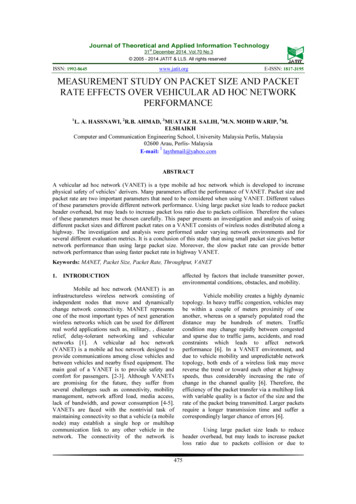


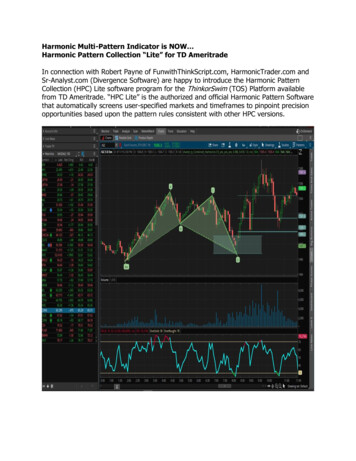
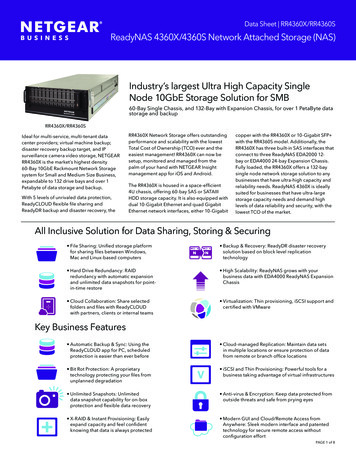
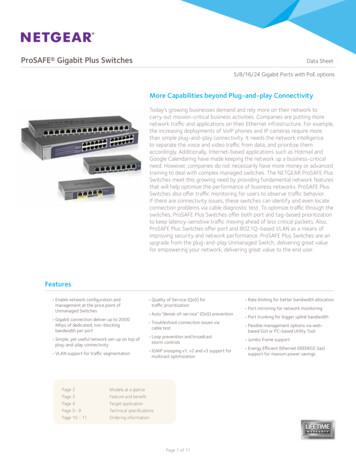
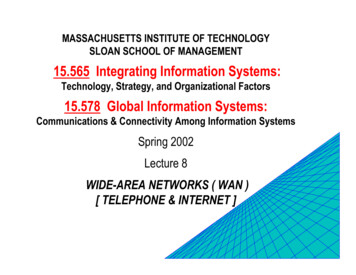
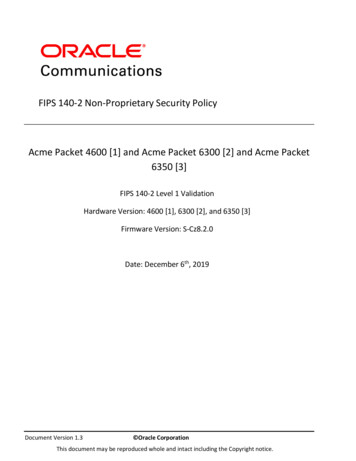
![FIPS 140-2 Non-Proprietary Security Policy Acme Packet 1100 [1] and .](/img/49/140sp3490-5601486.jpg)
